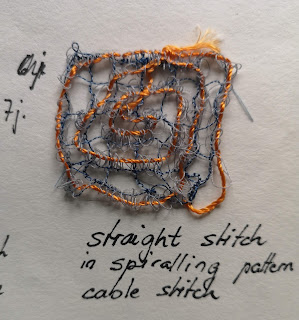Another sample which got cut up and woven with painted coton organza strips.
Sunday 14 March 2021
Chapter 6 - Revisited
Another sample which got cut up and woven with painted coton organza strips.
Wednesday 10 March 2021
Experiments using dissolvable fabric
Friday 5 March 2021
Module 6 - Chapter 7 - Use of Dissolvable Fabric
The next samples are done on different dissolvable materials ranging from fabric-like (e.g. Soluvlies, readily available here in Luxembourg) to plastic-like material like Avalon and Romeo.
The samples had a beginning size of 4 cm and shrunk slightly after the dissolving process. To keep the shape they should be pinned to a piece of Styropor, although this might make the dissolving process more difficult as you can't really feel how much the glue has disintegrated. Depending on how loosely the sample is stitched I find it easier to leave it sitting in water for some time.
The samples were stitched in the same way: first stitching a grid, then adding the circular shapes going vertically and overlapping.
Different stitch methods on soluble material
One last sample stitched onto adhesive Soluvlies with trapped pieces of fabric and cut painted transparency. Here some glue residue was left in the sample which was put over a little bowl for the drying process so that it would keep its shape.
Soluble lace methods to translate areas of drawings


























































